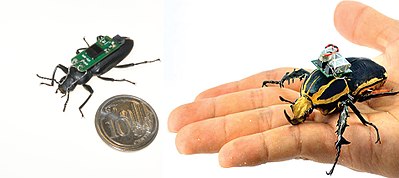Remote control animal
Three electrodes are implanted; two in the ventral posterolateral nucleus of the thalamus which conveys facial sensory information from the left and right whiskers, and a third in the medial forebrain bundle which is involved in the reward process of the rat.During training, the operator stimulates the left or right electrode of the rat making it "feel" a touch to the corresponding set of whiskers, as though it had come in contact with an obstacle.The rats could be instructed to turn left or right, climb trees and ladders, navigate piles of rubble, and jump from different heights.All components in the system are commercially available and are fabricated from surface mount devices to reduce the size (25 x 15 x 2 mm) and weight (10 g with battery).Even one of the pioneers in this area of study, Sanjiv Talwar, said "There's going to have to be a wide debate to see whether this is acceptable or not" and "There are some ethical issues here which I can't deny.A command module which contains a microprocessor, wireless radio, GPS receiver and an attitude and heading reference system (essentially a gyroscope) can be fitted to dogs.[10] Researchers responsible for developing remote control of a pigeon using brain implants conducted a similar successful experiment on mice in 2005.[19] The US-based company Backyard Brains released the "RoboRoach", a remote controlled cockroach kit that they refer to as "The world's first commercially available cyborg".The RoboRoach was the first kit available to the general public for the remote control of an animal and was funded by the United States' National Institute of Mental Health as a device to serve as a teaching aid to promote an interest in neuroscience.[27][6] In 2009, remote control of the flight movements of the Cotinus texana and the much larger Mecynorrhina torquata beetles has been achieved during experiments funded by the Defence Advanced Research Projects Agency (DARPA).[28][32] It has been suggested the beetles could be used for search and rescue mission, however, it has been noted that currently available batteries, solar cells and piezoelectrics that harvest energy from movement cannot provide enough power to run the electrodes and radio transmitters for very long.Although this frequency is lower than that observed with direct electrical stimulation of the giant fibre system, it is higher than that elicited by natural stimuli, such as a light-off stimulus.When an electric current is passed through the wire, it stimulates the shark's sense of smell and the animal turns, just as it would move toward blood in the ocean.The research has prompted protests from bloggers who allude to remote controlled humans or horror films featuring maniacal cyborg sharks on a feeding frenzy.Red-eared terrapins (Trachemys scripta elegans) were made to follow a specific path by manipulating the turtles' natural obstacle avoidance behaviour.[35] In 2007, researchers at east China's Shandong University of Science and Technology implanted micro electrodes in the brain of a pigeon so they could remotely control it to fly right or left, or up or down.[7] Other suggested fields of application include pest control, the mapping of underground areas, and the study of animal behaviour.In 2007, it was reported that scientists at the Commonwealth Scientific and Industrial Research Organisation had developed a prototype "invisible fence" using the Global Positioning System (GPS) in a project nicknamed Bovines Without Borders.The first is visual (white plastic flags spaced at intervals around the perimeter in the fenced-in area), the second is audible (the collar emits a sound when the animal wearing it approaches buried cable), and finally there's an electric shock to indicate they have reached the fence.




implantedcyborgsanimal welfareanimal rightsNon-invasivebeetlescockroachesdogfish sharkspigeonsworking animalssearch and rescuereward centreventral posterolateral nucleusthalamusmedial forebrain bundlerewarding electrical stimulusState University of New Yorksurface mount devicesDr Hadwen TrustHertfordshireRutgers Universitybrain-to-brain interfaceSprague-Dawleymotor cortexultrasonicepidermalGeneral Regression Neural NetworkmicroprocessorgyroscopeFranz Huberbrain of insectsmushroom bodyUniversity of MichiganTED talkTED GlobalKickstartermicrostimulationbluetoothsmartphoneUnited StatesNational Institute of Mental HealthneuroscienceParkinson's diseaseDeep Brain StimulationdeafnessCochlear implantsNorth Carolina State UniversityKinectCotinus texanaMecynorrhina torquataDefence Advanced Research Projects Agencyoptic lobesbasilar flight musclesNanyang Technological University, SingaporepiezoelectricsDrosophilaLigand-gated ion channelcalciumaction potentialscentral nervous systemSouth KoreanRed-eared terrapinsmesencephalongeckosperiaqueductal grayventral tegmental areamilitary usesmilitary dolphinsShock collarPet fenceCommonwealth Scientific and Industrial Research OrganisationGlobal Positioning SystemBrain implantCruelty to animalsMicroboticsNecroboticsOptogeneticsSurveillance toolsBibcodeAbbeel, PieterAnimal rights movementAnimal rights by country or territoryAnarchism and animal rightsAnimal rights and punk subcultureAnimal cruelty–Holocaust analogiesAnimal rights in Indian religionsChristianity and animal rightsHistory of animal rightsList of international animal welfare conventionsMoral status of animals in the ancient worldTimeline of animal welfare and rightsTotal liberationUniversal Declaration on Animal WelfareAbolitionismAhimsaAnimal cognitionAnimal consciousnessAnimal ethicsAnimal–industrial complexAnimal lawAnimal protectionismAnimal-free agricultureAnthrozoologyArgument from marginal casesCambridge Declaration on ConsciousnessCarnismEqual consideration of interestsEmotion in animalsEthics of eating meatEthics of uncertain sentienceEthologyInsects in ethicsIntrinsic valueMeat paradoxMoral circle expansionNonviolenceOpen rescueOpposition to huntingPersonismReplaceability argumentSentientismSpeciesismVeganismVegaphobiaVegetarianismAnimal agriculture